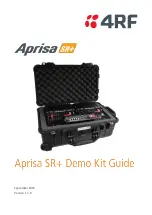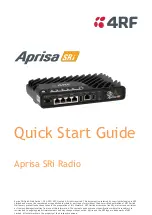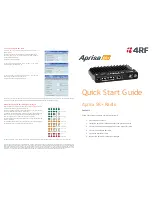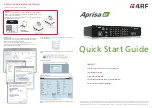
WJ-8711A DIGITAL HF RECEIVER
INSTALLATION
2-7
When the independent sideband (ISB) detection mode is selected, the LINE A output provides
upper sideband (USB) audio while the LINE B output provides lower sideband (LSB) audio. In all other
detection modes, the LINE A and LINE B outputs provide identical signal content.
The output signal level for input signals above the AGC threshold is 0 dBm nominal (
±
3 dB).
Output impedance for both line audio outputs is 600 ohms (
±
30 ohms). The bandwidth for both line audio
outputs is 0.1 to 13.0 kHz,
±
3 dB. Continuous short circuit protection is provided for both outputs.
2.2.4.7.2
Speaker Output (TB1 Terminals 7 and 8)
- Terminals 7 and 8 of TB1 provide an audio
output, sufficient to drive an external 8 ohm speaker. Terminal 7 is common (SPEAKER COM), and terminal
eight is positive (SPEAKER (+)). The bandwidth of the output audio is 0.1 to 13.0 kHz at
±
2 dB. Output
level is 2 Vrms minimum with less than 3% total harmonic distortion. A speaker output gain control knob is
located on the front panel. A clockwise rotation of this knob results in an increase in output signal level.
Lower sideband (LSB) or upper sideband (USB) audio can be selected individually or
combined, via the front panel SPEAKER switch while in the ISB detection mode, and made available at the
speaker output.
2.2.4.7.3
DC-Coupled Audio Output (TB1 Terminal 9)
- Terminal 9 of TB1 provides a DC-coupled
version of the audio provided at the speaker output (see
paragraph 2.2.4.7.2
).
2.2.4.7.4
Remote Signal Strength Indicator Output (TB1 Terminal 10)
- Terminal 10 of TB1
provides an analog output representing the strength of the current detected signal which can be used to drive
an external signal strength indicator. The output is a dc voltage which is a linear representation of the strength
of the received signal. The output is 0 Vdc for a signal strength of -120 dBm and +5 Vdc for a signal strength
of +10 dBm into a high impedance load. This signal is the same used to drive the front panel signal strength
meter.
2.2.4.7.5
Squelch Output (TB1 Terminal 11)
- Terminal 11 of TB1 provides a low impedance to
ground (capable of sinking 150 mA) when the receiver's signal squelch circuitry is activated (i.e., the detected
signal is above the set squelch level). This output is provided for system integration of the WJ-8711A. This
output appears as a +5 Vdc source through a 100 k
Ω
impedance when signal squelch is not active.
2.2.4.7.6
Mute Input (TB1 Terminal 12)
- Terminal 12 of TB1 is provided to accept a logic level
mute input from an external source. When the input at this terminal is grounded (or driven to a CMOS logic
low) all audio outputs of the receiver are disabled.
2.2.4.8
POWER, 90-264 VAC Line Power Input (FL1J1)
- This three-prong male receptacle
mates with the six-foot line power cord that is supplied with the receiver to supply the line voltage for the
unit's operation. Acceptable input power is 90-264 VAC at 47 to 440 Hz. The WJ-8711A requires
approximately 50 watts for operation.
2.2.4.9
PHONES, Front Panel Headphones Jack (A1J1)
- The PHONES connector located on the
front panel is a 1/4-inch stereo headphones jack. Each channel of this output provides a minimum of 10 mW
at less than 5% total harmonic distortion into a 600 ohm load, when the input signal is above the AGC
threshold. Located beside the PHONES jack on the front panel is a volume control knob. A clockwise
rotation of this knob results in an increase in headphones output signal level. When the independent sideband
Courtesy of http://BlackRadios.terryo.org
Summary of Contents for WJ-8711A
Page 4: ...iv THIS PAGE INTENTIONALLY LEFT BLANK Courtesy of http BlackRadios terryo org...
Page 19: ...1 i SECTION I GENERAL DESCRIPTION Courtesy of http BlackRadios terryo org...
Page 33: ...2 i SECTION II INSTALLATION Courtesy of http BlackRadios terryo org...
Page 34: ...2 ii THIS PAGE INTENTIONALLY LEFT BLANK Courtesy of http BlackRadios terryo org...
Page 47: ...3 i SECTION III LOCAL OPERATION Courtesy of http BlackRadios terryo org...
Page 48: ...3 ii THIS PAGE INTENTIONALLY LEFT BLANK Courtesy of http BlackRadios terryo org...
Page 93: ...4 i SECTION IV RS 232 REMOTE OPERATION Courtesy of http BlackRadios terryo org...
Page 94: ...4 ii THIS PAGE INTENTIONALLY LEFT BLANK Courtesy of http BlackRadios terryo org...
Page 123: ...5 i SECTION V CSMA REMOTE CONTROL Courtesy of http BlackRadios terryo org...
Page 124: ...5 ii THIS PAGE INTENTIONALLY LEFT BLANK Courtesy of http BlackRadios terryo org...
Page 143: ...6 i SECTION VI CIRCUIT DESCRIPTION Courtesy of http BlackRadios terryo org...
Page 157: ...7 i SECTION VII MAINTENANCE Courtesy of http BlackRadios terryo org...
Page 158: ...7 ii THIS PAGE INTENTIONALLY LEFT BLANK Courtesy of http BlackRadios terryo org...
Page 189: ...8 i SECTION VIII REPLACEMENT PARTS LIST Courtesy of http BlackRadios terryo org...
Page 190: ...8 ii THIS PAGE INTENTIONALLY LEFT BLANK Courtesy of http BlackRadios terryo org...
Page 241: ...FP i FOLDOUTS Courtesy of http BlackRadios terryo org...
Page 242: ...FP ii THIS PAGE INTENTIONALLY LEFT BLANK Courtesy of http BlackRadios terryo org...
















































